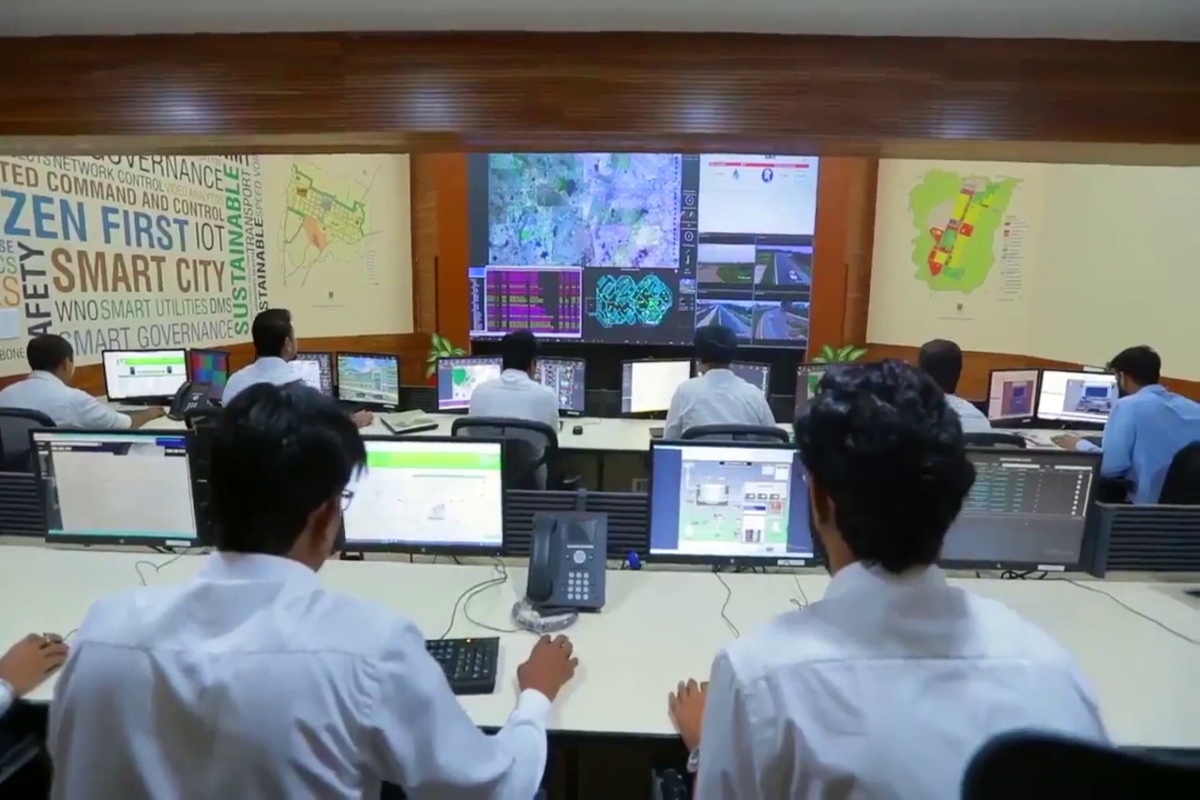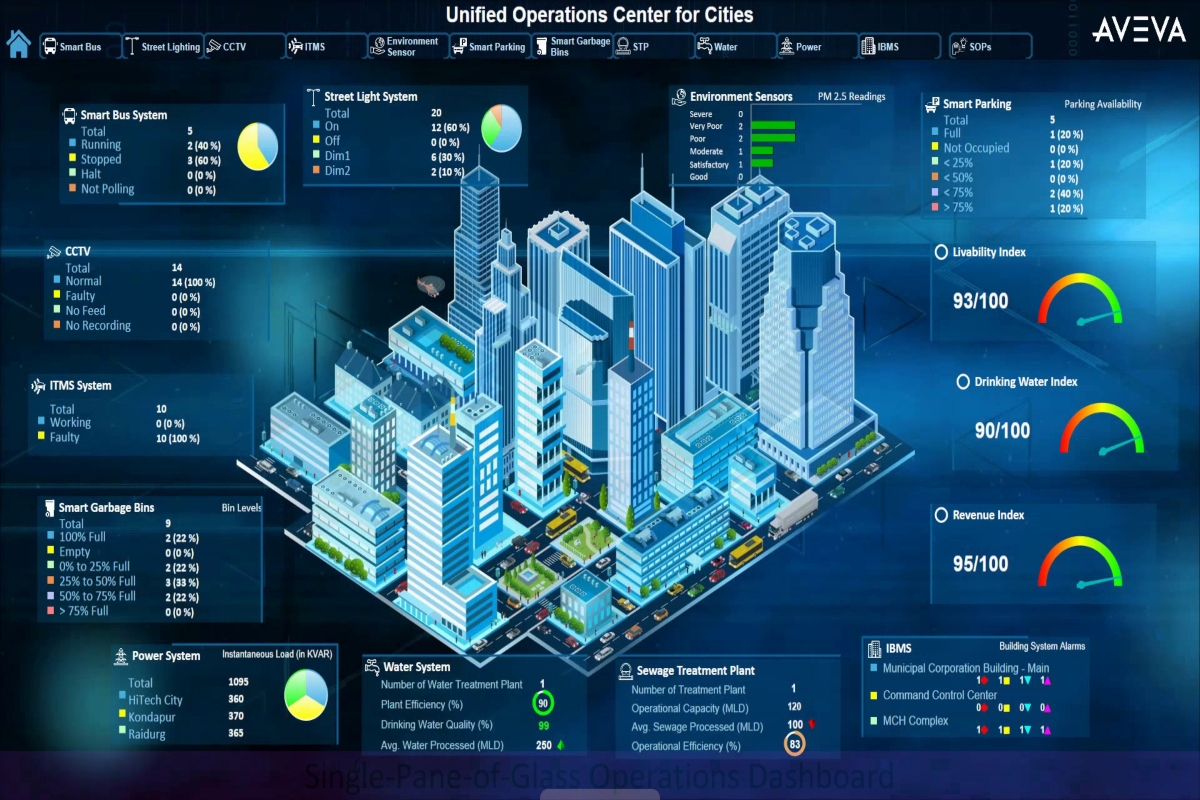Using digital twins to maximise returns on existing infrastructure
Published on by Water Network Research, Official research team of The Water Network in Case Studies
If cities have access to dynamic, coordinated and timely information about local infrastructure, its performance and its pressure points, they can unlock major operational and financial benefits.

The command and control centre of Nava Raipur
This article is an extract from our recent Trend Report on digital twins , sponsored by AVEVA.
There is far more to smart cities than futuristic planning. To focus exclusively on new infrastructure and new-build programmes is to ignore the significant potential for everyday operational and maintenance benefits, and budget savings, which city and even town planners and managers could exploit today.
That’s if they had access to dynamic, coordinated and timely information about local infrastructure, its performance and its pressure points – in such a way that enabled targeted and effective action by operational teams and engineers, to keep services running smoothly whatever the prevailing conditions.
Funding gaps
There are sound financial reasons for making existing infrastructure smarter and better connected too. A significant one is the scope to bridge budget shortfalls: the funding gap between the cost of the shiny new facilities cities and towns would ideally implement to meet local needs, and local governments’ available resources.
Making better use of existing infrastructure, and/or extending its useful life, should be a priority for any public administration, state-funded organisation, or private service provider keen to deliver value to stakeholders and to demonstrate a commitment to sustainability. Apart from anything else, optimising use of existing resources may help free up budget for more ambitious and futuristic smart city innovation.
Utility of the future
One public organisation currently championing smarter planning and resource use is the Department of Water Resources (DWR) in Gwinnett County, Georgia, in the United States. The Department is highly ambitious, looking to intelligent use of data – ultimately including targeted data-sharing with external partner organisations – to maintain quality services for local residents and businesses.
“Our aim, and the county’s mission, is that the DWR becomes ‘the utility of the future’,” says Sam Paul, who looks after the organisation’s SCADA (supervisory control and data acquisition) operational technology (OT) systems which collect and analyse real-time operational data. These critical control systems allow the department to monitor and optimise water infrastructure, by targeting maintenance and pre-empting peaks in demand so that supplies never run dry.
“Our goal was connected systems, shared data and new collaboration – and, above all, to be useful.”
The trailblazing part of Gwinnett County’s plan is the desire to share operational information, such as water collections/reserves data, with external partners. These include the county’s emergency operations control centre – so that it in turn can monitor and respond to the impact of bad weather, natural disasters, or other acute scenarios.
Data exchange with the county fire department, meanwhile, helps ensure that residents and local businesses are not affected if there is a sudden, sharp rise in demand for water in a particular neighbourhood – for instance, as firefighters tap into hydrants to tackle a major blaze.
IT systems silos
Up to now, traditional ‘walls’ between the different teams and their respective IT system silos have limited the scope for sharing intelligence and collaborating in innovative new ways. For Gwinnett County’s water department, surmounting these barriers was the critical first step to service transformation.
“Our goal was connected systems, shared data and new collaboration – and, above all, to be useful,” Sam Paul explains. “This meant being able to create end-to-end visibility and the ability to control infrastructure holistically – spanning engineering, maintenance and operations.”
With a clear vision for service transformation – based on optimised performance, operational excellence and ultimately a reliable and consistent supply of clean water to Gwinnett County residents – the DWR’s next priority was to establish the technology to support a clear line of sight across engineering, maintenance and operations.
“Now, the emphasis is on automated data feeds which carries with it the expectation that people will trust that data, and the connectivity from production.”
“We needed to break down the barriers with technology and make data usable outside production, to wider populations including engineers, research teams and more; to support smarter, more prompt trouble-shooting, diagnostics, and design and development.”
Over the course of five years, the DWR has moved from a scenario comprising multiple, separate OT and IT platforms (each plant had its own SCADA platform), to one in which everything is standardised on the same, optimised platform. This allows data to flow from two water production plants, 8,000+ miles of distribution and transmission networks, hundreds of water collection points, and three water reclamation facilities.
That includes diagnostic data about the function and performance of pumps, their energy use and their output, which can be shared with both maintenance and design engineers.

The AVEVA Unified Operations Centre for Cities
Cultural barriers
Traditional mindsets and entrenched ways of working can be another barrier to smarter and more collaborative infrastructure management. Where teams have been monitoring and managing assets in a particular way for years or decades, it is not unusual for there to be some resistance to change – especially if this involves a leap of trust from the physical to the ‘virtual’– in other words, greater reliance on data feeds to support decision-making and actions.
This can be even more challenging in the context of municipal infrastructure, where an ageing workforce is challenging cities to hire and train next-generation support staff. Gwinnett County DWR has encountered this. Its evolving set-up has required some cultural adaptation over recent years, as part of its ‘digital transformation’ towards smarter, co-ordinated and targeted data-based operations, maintenance and design/R&D.
“Traditionally, feedback has been a physical touch-and-feel process involving lifting man-hole covers,” Paul explains. “Now, the emphasis is on automated data feeds – data collection, analysis and advanced modelling/calculations – which carries with it the expectation that people will trust that data, and the connectivity from production.”
The digital twin
Making sure different teams can readily access and visualise the information and insights that are most pertinent to their roles is proving critical here. To this end, the DWR worked with AVEVA to establish a ‘digital twin’ or digital representation of its entire infrastructure on a secure, enterprise-wide software platform.
A state-of-the-art digital twin is essentially an integrated, centralised platform (or ‘nerve centre’), where diverse information about assets and associated services is combined, monitored, analysed and acted upon. It can be a critical facilitator of transformation – delivering benefits across all phases of the lifecycle of designing, running and maintaining/improving local infrastructure, whether within a single organisation or across an entire city.
“We needed to break down the barriers with technology and make data usable outside production to support smarter, more prompt trouble-shooting, diagnostics, and design and development.”
All of the different teams at DWR can access and view this, and interpret the data feeds in a way that is meaningful to the work they do. This is displayed via a consolidated graphical dashboard, which is customisable to each team or role, and allows views from a high-level as well as via a drill-down capability to individual plants, systems or unit operations.
The operations department can use the insights to optimise pump performance and water flow. Maintenance teams can hone their response in the case of alarms being triggered and are better able to pinpoint where urgent attention is needed. Research and development team members can use the data to monitor infrastructure performance, with a view to improving it in the future.
Looking to greenfield smart cities for inspiration
Although greenfield smart cities, which are built from the ground up to take advantage of the latest technology innovation, have obvious advantages over more established urban environments, they offer a useful reference point for the kinds of coordinated infrastructure management scenarios that all cities might aim for.
Take Indian greenfield smart city Nava Raipur. Here, plans for a highly coordinated, smart urban infrastructure are being optimised with a single, integrated command and control centre built on AVEVA’s Unified Operations Centre software, which looks after everything from CCTV to energy management, traffic management systems, and city helpdesk applications.
Sub-systems (for each utility and service) are integrated – enabling rapid, coordinated crisis and emergency management, with everyone working from a ‘single source of the truth’.
Salil Rai Shrivastava, engineer-in-chief at SNVP, said: “Even where this response is escalated and outsourced to third parties, it is all coordinated from the same central city platform.”
A digital twin/unified operations centre approach can help, by connecting disparate systems, and allowing diverse data to be collected and aggregated in a common repository and analysed.
Taxonomy
- Smart City
- Digital Twins